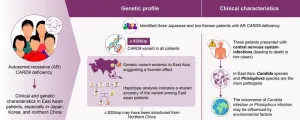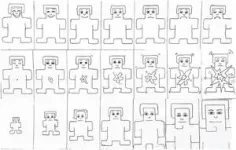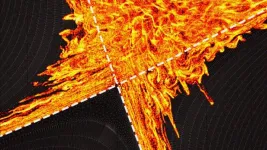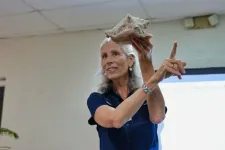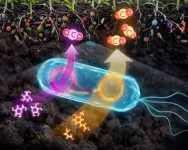Shedding light on the origin of a genetic variant underlying fungal infections
2024-06-11
(Press-News.org)
Researchers from Japan uncover the genetic diversity and regional patterns of CARD9 deficiency in patients susceptible to fungal diseases
Tokyo, Japan – Fungal infections pose life-threatening risks, especially when vital organs or the central nervous system are affected. Individuals harboring variants in the CARD9 gene are particularly susceptible to invasive fungal infections, given that the protein coded by this gene serves as a critical regulator of the immune system. A recent discovery by Tokyo Medical and Dental University (TMDU) researchers suggests that a specific variant of CARD9 prevalent across northern China, Korea, and Japan may have originated from a common ancestor.
In their study published on 17 May 2024 in the Journal of Clinical Immunology, the researchers from TMDU conducted genetic analyses on Japanese and Korean patients who suffered from severe or recurring fungal infections. Their goal was to shed light on the genetic and clinical traits of individuals affected by CARD9 deficiency in East Asia.
The study included a total of five patients who were deficient for CARD9. Among them, two Japanese patients were newly identified as carriers of biallelic variants of CARD9 via DNA sequencing conducted by the research team, prompted by their medical history of fungal infections. Notably, both of these patients, along with three other patients who had previously been investigated, two Korean and one Japanese, were identified as carriers of a CARD9 variant called c.820dup.
“The global distribution of CARD9 deficiency is biased, with high incidence in North Africa, the Middle East, and China. Notably, the distribution of CARD9 variants is also biased, with the c.820dup variant being relatively common in China,” explains Prof. Hirokazu Kanegane, the lead researcher of the study.
The fact that all five patients shared the same variant caught the researchers’ attention. They hypothesized that this scenario could be explained by the “founder effect,” where a variant becomes common in a population that originated from a small group of ancestors. To verify their hypothesis, the researchers performed haplotype analyses. Put simply, they examined groups of genes that are inherited together from a parent (haplotypes) to determine whether these genes were identical among the five patients and matched previously sequenced haplotypes from Chinese CARD9-deficient patients.
Interestingly, they found strong evidence suggesting that all haplotypes containing the c.820dup variant were exactly the same. With further statistical genetic analyses, the researchers estimated the age of the c.820dup variant itself, which turned out to be between 2,000 and 4,000 years. Remarkably, the estimated variant’s age and its distribution in Japan, Korea, and China are perfectly in line with the history of the East Asia region. “Modern Japanese and Koreans are believed to have a genetic background originating from northern China. During the late Neolithic to the Bronze Age, the migration of people from northern China to Korea and Japan spread rice and language. The origins of the variant identified in this study are consistent with this historical period,” remarks Prof. Kanegane. “We thus conclude that this variant originates from a common ancestor, estimated to have lived less than 4,000 years ago.”
Additionally, although the variant observed was the same, the clinical presentation of patients from Japan and Korea differed from that of Chinese patients according to medical records. More specifically, Chinese patients often suffered from black mold infections caused by the genus Phialophora, whereas none of the five patients from Japan and Korea exhibited such infections. The researchers ascribed this discrepancy to environmental factors, possibly related to the more rural lifestyle in northern China.
Together, the findings of this interdisciplinary study make important contributions to our knowledge of anthropology, genetics, and medicine, and shed light on how genetic variants can propagate across different regions and through generations.
###
The article, “Inherited CARD9 Deficiency Due to a Founder Effect in East Asia,” was published in the Journal of Clinical Immunology at DOI: 10.1007/s10875-024-01724-7
END
ELSE PRESS RELEASES FROM THIS DATE:
2024-06-11
When the COVID-19 pandemic hit, it sent shock waves across global supply chains. But manufacturers and other businesses weren’t the only ones hit hard: local and international aid organizations, tasked with providing humanitarian assistance during times of crisis, suddenly had a major crisis of their own. How would they get the supplies they needed to carry out their crucial work?
According to a new study by the UBC Sauder School of Business, the organizations showed remarkable nimbleness and ingenuity — and while the pandemic was an unusual event, their approaches can provide powerful insights ...
2024-06-11
Fukuoka, Japan—Researchers from Kyushu University have uncovered new variations to a traditional illusion, based on how we perceive the motion of flashing lights. Published on May 21 in i-Perception, the findings show that when three light flashes are presented in rapid succession in our side vision, our brain tends to perceive them in a straight line, with the second flash around the midpoint, no matter the actual location of the second flash. This research, which earned the journal’s Early Career Best Paper Prize this year, offers new perspectives on perceptual errors ...
2024-06-11
Tsukuba, Japan—Viruses are ubiquitous in the environment, and organisms have developed various mechanisms to counter their threat. However, the genome of actinomycetes contains a highly conserved gene set encoding virus-like nanoparticles, although its biological significance has remained unclear.
In this study, researchers examined Streptomyces davawensis, an actinomycete species, and discovered that it produces virus-like particles that facilitate host reproduction. Extracellular DNA, which serves as a scaffold for multicellular organization, was significantly reduced in the colonies of mutant S. davawensis strains ...
2024-06-11
TORONTO, ON, June 11, 2024 — What scientists previously thought about where Fast Radio Bursts (FRBs) come from is just the tip of the iceberg, according to new research led by astronomers at the University of Toronto. The mysteries of the millisecond-long cosmic explosions are unfolding with a new way of analyzing data from the Canadian Hydrogen Intensity Mapping Experiment (CHIME).
Published today in The Astrophysical Journal, the study details the properties of polarized light from 128 non-repeating FRBs — those from sources that have ...
2024-06-11
WASHINGTON, June 11, 2024 — Journalists who register for the fall meeting of the American Chemical Society (ACS) will have access to about 10,000 presentations on topics including agriculture and food, energy and fuels, health and medicine, sustainability, and more. ACS Fall 2024 is a hybrid meeting being held virtually and in person in Denver on Aug. 18-22, with the theme “Elevating Chemistry.”
ACS considers requests for press credentials and complimentary meeting registration from reporters (staff and freelance) and public information officers at government, nonprofit and educational institutions. Please ...
2024-06-11
The furious exhaust heat generated by a fusing plasma in a commercial-scale reactor may not be as damaging to the vessel’s innards as once thought, according to researchers at the U.S. Department of Energy’s (DOE) Princeton Plasma Physics Laboratory (PPPL), Oak Ridge National Laboratory and the ITER Organization (ITER).
“This discovery fundamentally changes how we think about the way heat and particles travel between two critically important regions at the edge of a plasma during fusion,” said PPPL Managing Principal Research Physicist Choongseok Chang, who led ...
2024-06-11
WASHINGTON—The Endocrine Society endorses the Right to IVF Act, which was introduced by Senators Cory Booker (D-NJ), Patty Murray (D-WA) and Tammy Duckworth (D-IL) to protect and expand nationwide access to fertility treatment, including in vitro fertilization (IVF), and urges the Senate to pass the Right to IVF Act on June 12th to ensure that the freedom to start and grow a family is protected and accessible to everyone in the United States.
Infertility affects an increasing number of individuals. ...
2024-06-11
The queen conch (Aliger gigas) is a prized delicacy long harvested for food and revered for its beautiful shell. With a lifespan between 25 to 40 years, the queen conch is second only to the spiny lobster fishery and is the most important molluscan fishery in the Caribbean region.
Deeply rooted in the way of life in the Caribbean, many island communities depend on queen conch for their livelihoods. However, intensive fishing and habitat degradation from urbanization and climate change have caused conch populations ...
2024-06-11
The toxic gas ethylene oxide, at levels thousand times higher than what is considered safe, was detected across parts of Louisiana with a cutting-edge mobile air-testing lab. The concentrations found dwarfed Environmental Protection Agency estimates for the region.
The findings, led by Johns Hopkins University environmental engineers, suggest significantly higher cancer risks for people who live near facilities that manufacture and use ethylene oxide, as well as a need for more accurate and reliable tools to monitor emissions.
“I don’t think there’s any census track in the area that wasn’t at higher risk for cancer than we would deem acceptable,” said ...
2024-06-11
When soil microbes eat plant matter, the digested food follows one of two pathways. Either the microbe uses the food to build its own body, or it respires its meal as carbon dioxide (CO2) into the atmosphere.
Now, a Northwestern University-led research team has, for the first time, tracked the pathways of a mixture of plant waste as it moves through bacteria’s metabolism to contribute to atmospheric CO2. The researchers discovered that microbes respire three times as much CO2 from lignin carbons (non-sugar aromatic units) compared to cellulose carbons (glucose sugar units), which both add structure and support ...
LAST 30 PRESS RELEASES:
[Press-News.org] Shedding light on the origin of a genetic variant underlying fungal infections
